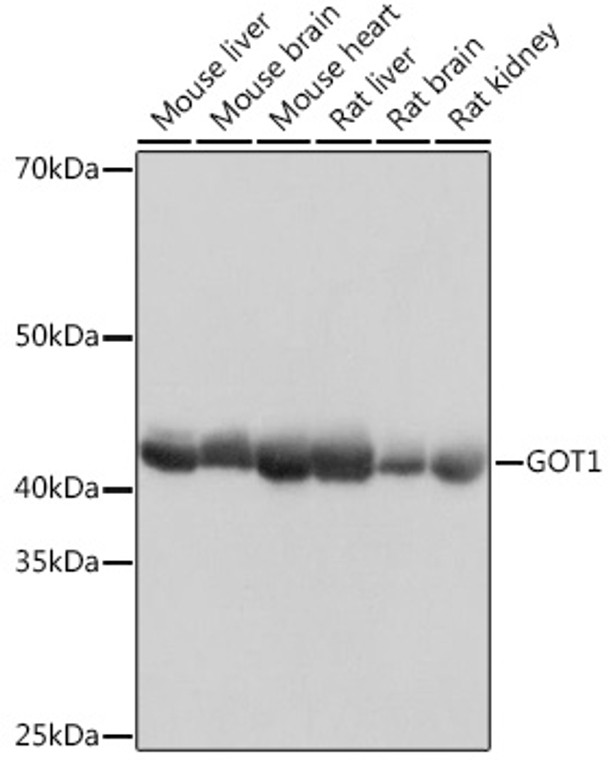| Host: |
Rabbit |
| Applications: |
WB/IF |
| Reactivity: |
Human/Mouse/Rat |
| Note: |
STRICTLY FOR FURTHER SCIENTIFIC RESEARCH USE ONLY (RUO). MUST NOT TO BE USED IN DIAGNOSTIC OR THERAPEUTIC APPLICATIONS. |
| Short Description: |
Rabbit monoclonal antibody anti-GOT1 (150-250) is suitable for use in Western Blot and Immunofluorescence research applications. |
| Clonality: |
Monoclonal |
| Clone ID: |
S7MR |
| Conjugation: |
Unconjugated |
| Isotype: |
IgG |
| Formulation: |
PBS with 0.02% Sodium Azide, 0.05% BSA, 50% Glycerol, pH7.3. |
| Purification: |
Affinity purification |
| Dilution Range: |
WB 1:500-1:2000IF/ICC 1:50-1:200 |
| Storage Instruction: |
Store at-20°C for up to 1 year from the date of receipt, and avoid repeat freeze-thaw cycles. |
| Gene Symbol: |
GOT1 |
| Gene ID: |
2805 |
| Uniprot ID: |
AATC_HUMAN |
| Immunogen Region: |
150-250 |
| Immunogen: |
A synthetic peptide corresponding to a sequence within amino acids 150-250 of human GOT1 (NP_002070.1). |
| Immunogen Sequence: |
AAGFKDIRSYRYWDAEKRGL DLQGFLNDLENAPEFSIVVL HACAHNPTGIDPTPEQWKQI ASVMKHRFLFPFFDSAYQGF ASGNLERDAWAIRYFVSEGF E |
| Function | Biosynthesis of L-glutamate from L-aspartate or L-cysteine. Important regulator of levels of glutamate, the major excitatory neurotransmitter of the vertebrate central nervous system. Acts as a scavenger of glutamate in brain neuroprotection. The aspartate aminotransferase activity is involved in hepatic glucose synthesis during development and in adipocyte glyceroneogenesis. Using L-cysteine as substrate, regulates levels of mercaptopyruvate, an important source of hydrogen sulfide. Mercaptopyruvate is converted into H(2)S via the action of 3-mercaptopyruvate sulfurtransferase (3MST). Hydrogen sulfide is an important synaptic modulator and neuroprotectant in the brain. In addition, catalyzes (2S)-2-aminobutanoate, a by-product in the cysteine biosynthesis pathway. |
| Protein Name | Aspartate Aminotransferase - CytoplasmicCaspatCysteine Aminotransferase - CytoplasmicCysteine Transaminase - CytoplasmicCcatGlutamate Oxaloacetate Transaminase 1Transaminase A |
| Database Links | Reactome: R-HSA-1237112Reactome: R-HSA-70263Reactome: R-HSA-8963693 |
| Cellular Localisation | Cytoplasm |
| Alternative Antibody Names | Anti-Aspartate Aminotransferase - Cytoplasmic antibodyAnti-Caspat antibodyAnti-Cysteine Aminotransferase - Cytoplasmic antibodyAnti-Cysteine Transaminase - Cytoplasmic antibodyAnti-Ccat antibodyAnti-Glutamate Oxaloacetate Transaminase 1 antibodyAnti-Transaminase A antibodyAnti-GOT1 antibody |
Information sourced from Uniprot.org
12 months for antibodies. 6 months for ELISA Kits. Please see website T&Cs for further guidance

![Anti-GOT1 antibody (150-250) [S7MR] (STJ11101317)](https://cdn11.bigcommerce.com/s-zso2xnchw9/images/stencil/760x760/products/90230/359294/STJ11101317_1__54492.1713123727.jpg?c=1)







